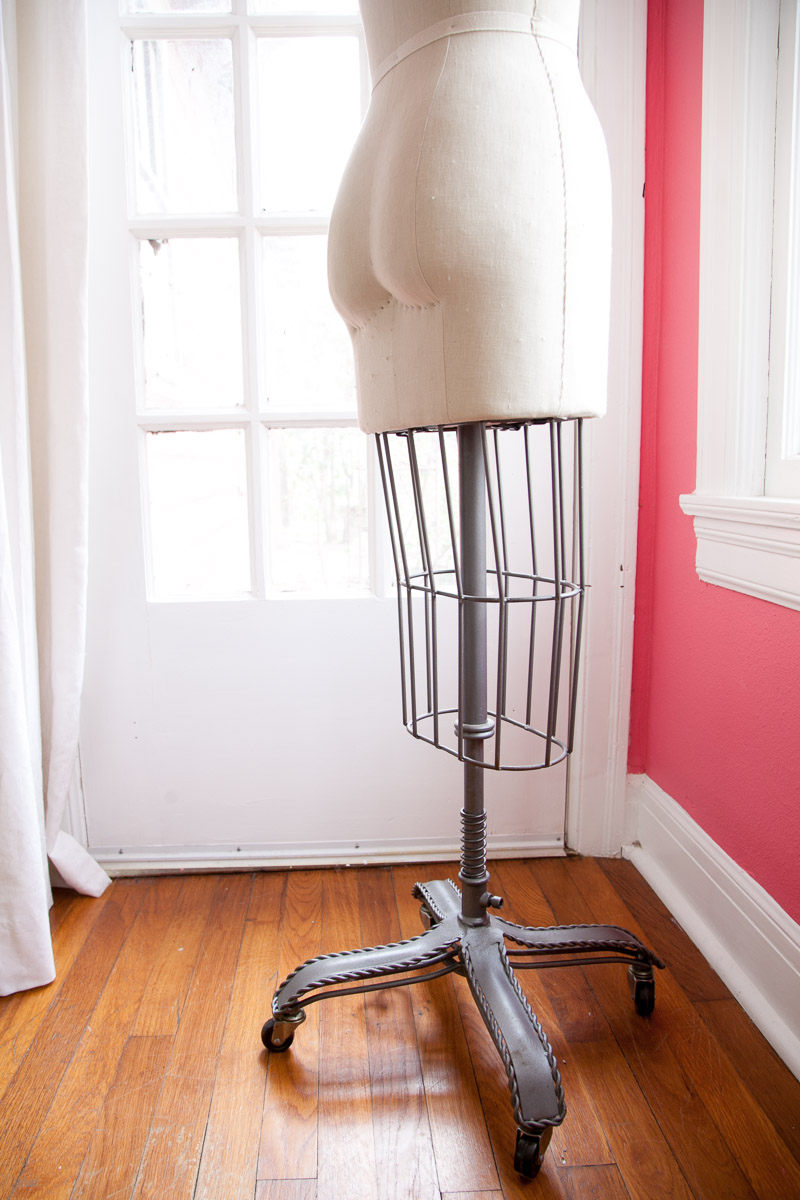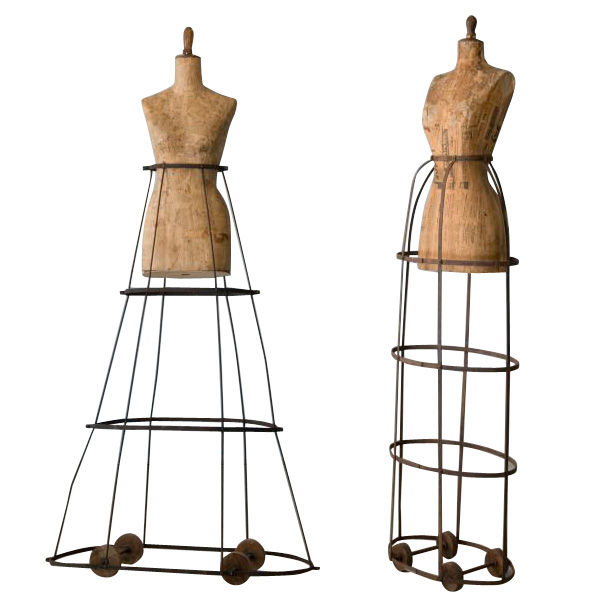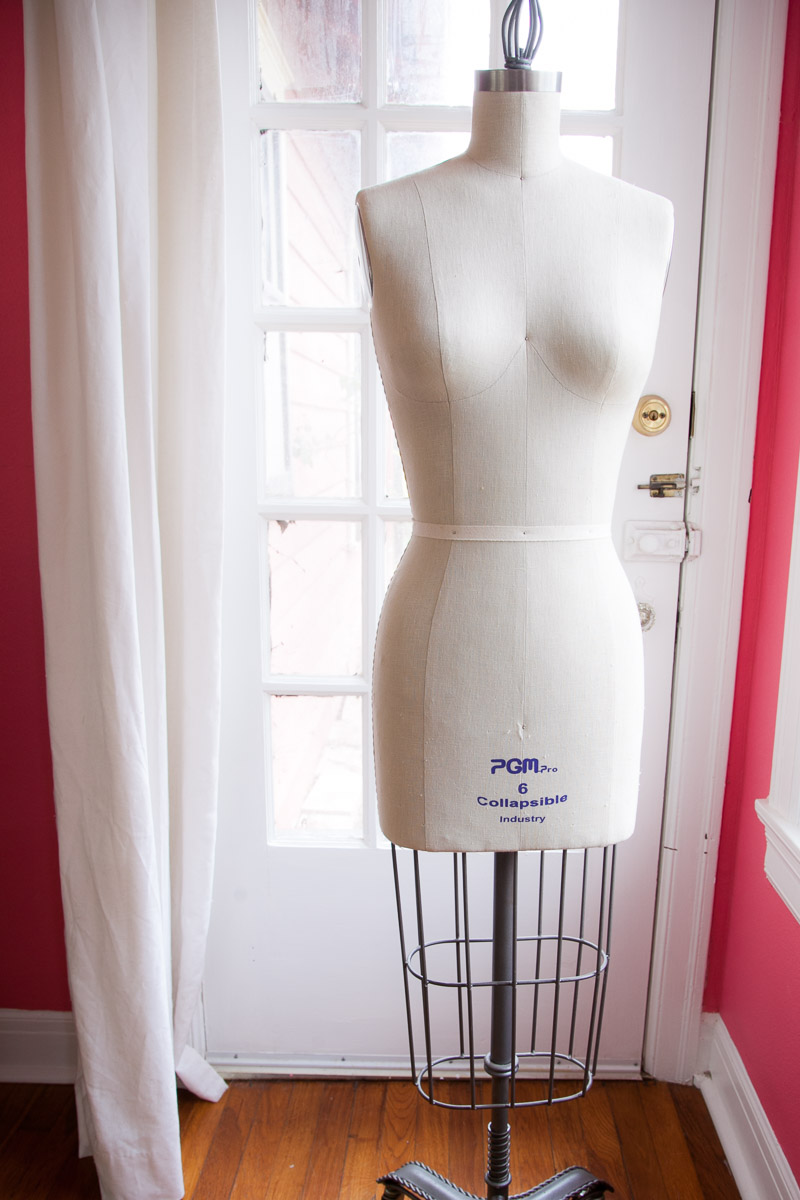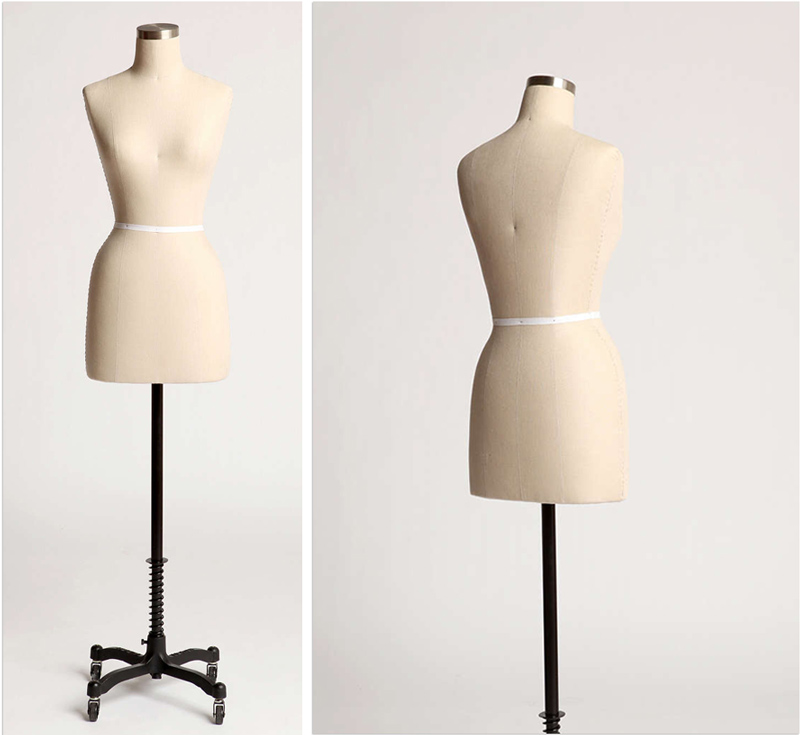
Let’s talk about one of sewing’s favorite subjects: dress forms!
Over the last month I’ve been shopping for a new dress form, both by doing a bit of online “window shopping” and by asking questions of various dealers and makers. It’s been a fun process!
The first time I went shopping for a dress form, circa 2002, I had access to very little information about them. The little that was out there on the internet about patternmaking and draping seemed to reinforce the mystique of, or my need for, a dress form. I was convinced that I needed one for any kind of serious sewing work.
Of course this was fueled in no small part by my lifelong romantic ideals of fashion designers all draping away on their dress forms. When I was a teenager, I used to imagine that a vintage Wolf form was something Molly Ringwald’s Pretty in Pink character might have kept in the corner of her bedroom. And I adored that character (what she did to that prom dress!).
I now own two dress forms. I bought one for personal use and one for professional pattern work and display photography. However, neither fills the specific need I have at the moment.
Why You May Want a Dress Form
Before I dive into dress form specifics, let’s talk about all the reasons one might want a dress form:
- You are a professional custom dressmaker or fashion design student who needs a form, or several forms, for patternmaking and draping. Chances are you already know what kind of forms work for you, based on your training, your clients, or what your school recommended to you.
- You often make very fitted patterns with a lot of design details, and want a dress form to assess style lines, or play with the drape of fabric.
- You draft your own patterns but prefer draping as part of the drafting process, rather than only working with flat patternmaking. It helps you visualize ideas.
- You want a form to mimic your body so you can use it as a fitting tool.
- You are a blogger or shop owner who needs a prop for styling and taking photographs.
- You are a collector! Or you simply want a fun clothes/jewelry showpiece in your house.

Do any of these stand out for you?
Knowing what you really want to use it for can help you choose from among the various dress form styles.
For example, when I look at this list, I’m most drawn to a form that works for both blog photo styling and makes an interesting collector’s piece. I’d also like the ability to pad the form for fitting purposes in the future. So I’m interested in looks as much as function.
Clearly I don’t prioritize having a form for fitting or draping purposes, which is probably the biggest reason many sewists want a dress form. The truth is, even if I had a better form or a totally customized body cast I don’t think I would use it very much for fitting. I prefer to fit directly on my body, and I can often visualize what flat pattern adjustments are going to do.
However, if you have trouble visualizing adjustments or pattern lines, a form might be a helpful tool!
Types of Dress Forms
Now let’s have a look at some of the different form types out there.
1. Professional dress form with cast iron base. These kind of forms are usually made with papier mache, padded with a few layers of cotton wadding and covered in linen. These are usually available either as a classic dressmaker form with a skirt cage or as a full body with legs.
Among these kind of forms is a huge variety in quality, and I’ll talk more specifics about these forms in my next post.

2. Display form. These forms are often designed to look just like sewing forms but they are really produced for display purposes. The form is usually made from either foam or fiberglass, and have a more simplified body shape to them.
Some dress forms cover a middle ground between professional sewing form and display form. For example, Urban Outfitters is selling this dress form, which was probably produced as an inexpensive form by one of the major form makers:

Although it is advertised as a sewing tool, it doesn’t have collapsible shoulders, is made from foam, and the stand has a height pedal that is purely decorative. You’ll also notice that the body shape is quite simplified, with absolutely no butt.
3. Adjustable dress form. These are the forms with dials that allow you to expand and contract the form as needed for different measurements.
4. Handmade dress form. There are a lot of fun methods for making a totally customized body form: plaster-casting, duct-tape and papier mache. Among these methods I’d include the mother of all crazy inventions, the Uniquely You form, which is a compressible foam form that you squeeze into a custom-fitted cover. Whoever first came up with the name “torpedo boobs” for this form deserves a sewing hall of fame star! I own one of these babies, too. A story for another day.
An important thing to keep in mind is that most dress forms can’t totally replace the work of fitting on an actual body. Bodies move and breathe. Most of these forms need work in order to replicate important body measurements and posture.
If you don’t need to do a lot of heavy fitting work, almost any of these will work for light sewing purposes. What you choose depends on budget, how much you need to fit precisely, or whether or not the form is for other non-sewing purposes.
—-
So after all this you may wonder what I’ve chosen for myself! As I mentioned I have a very specific need and I’ve narrowed it down to a few options. I’ll share more about that, along with what I loved and disliked about particular forms, in my next post.
Do you have a form? What do you use it for? What do love or wish you could change about it? And if you’ve blogged about your form, do share a link. I love reading dress form posts!
Would you like tips and inspiration in the craft of lingerie sewing? Sign up for my weekly eletter The Lingerie Maker.

I mostly wanted a dress form for fitting purposes, so I tried a few of the DIY options first. Dress form #1 was a duct tape version, but I didn’t use enough tape, and it exploded when I tried to fill it with foam. Dress form #2 was a plaster-casted version, and it turns out that posture is super important! It started to slip because it was taking so long to get all the plaster on, and so I slouched to keep it from slipping and that dress form ended up nicknamed pregnant Laura. 🙂 My third and final version is a Uniquely You form, but I haven’t gotten around to shaving off the torpedo boobs and properly fitting it yet. I think it will be a good fit for me though.
Oh, and that doesn’t include the first dress form I purchased at a garage sale back in high school, which is a vintage wire form, which is totally impractical for any kind of sewing but looks awesome!
Hi Laura, I love vintage forms! If I had more space I’d totally scrounge for one. Also love that you have tried various custom forms. I’m sure you learned so much from doing them!
Oo, I love reading about dress forms! I have an adjustable Dritz, which my lovely husband scored for free from a friend. It works really well for all the alteration work I do (mainly formals for teens), but I dream of having a lovely dress form that is a little less…utilitarian. Maybe then I’d actually photograph my work :p
Hi Kristin, it’s great to hear about your work with alterations! And how could anyone pass up a free form? I’d imagine that these forms would work just fine for basic alterations.
You could construct a cover for it to beautify it for photo shoots.
Love your form’s bum! I’m jealous.
I have a homemade custom form as well. My first – Big Bertha – was a Duct Tape Double. Boy was she heavy. So much so she broke her leg / stand. My current one – Q – is a Paper Tape Double & is hollow inside. Obviously fitting was a big priority. I wouldn’t go through the hassle of custom form otherwise. But I guess the ultimate goal is to design by draping as well. So I made sure Q is pinnable. I blogged about my form making process here.
I don’t really use Q to model my makes though. I like seeing people’s makes on real bodies – it brings the garments to life. I might reconsider if I start making blush inducing garments!
Hi Pia, thanks for chiming in. I love your posts about the moulage (and sleeve gussets!) and your dress form process. So much good analysis!
Even though I’m shy and don’t love taking photos of myself, I also prefer modeling my own clothes in photos, but my lingerie is off limits. That’s one of my big reasons for a new form.
The first dress form I ever used was a papier mache one made for my mother about 14 years before I was using it. But I knew nothing about fitting (I learned to sew during the 80s when the only fit that mattered was a waistband between blousy tops and full-pleated bottoms). Fast forward about 15 years and I purchased a Dritz adjustable one that seemed to work well. But again, I wasn’t sewing much, and didn’t know anything about fitting properly. Recently DH helped me make a duct-tape version, which is very useful. It’s not perfect and it’s not pretty, but it is a boon when it comes to fitting issues for myself. Oh, and I own a Vintage Judy, fully adjustable, that dates from around 1950, which is good for hanging clothes on, and that’s about it.
You’re lucky to have someone to help you! I can’t think of anyone that I can talk into taping my body ;). Also I think my mother has a 50s or 60s vintage adjustable form that she found at a garage sale. Those are really fun collector’s pieces.
I have three forms. One from design school a royal, which I’ve used for a couple bridal clients which were the same size, one my size which I like to drape my own designs on, a Cyber, and one full body child size 5, a Wolf. I use that to make designs for my daughter and her sister when she was younger. I prefer draping to flat patterning.
Hi Justine, ooh, Cyber is a new name to me! Royals are really great forms. I really understand that draping is a big part of bridal designing for a lot of people. Thanks for sharing!
Most likely not for you because you don’t use for fitting, but I had a custom Wolf form made, it’s beautiful and something I’ll have forever. The experience of having it done was the best too! I went to their location in NJ to be measured and was amazed that what I thought would be a major organization is a small mom and pop shop with less than 25 employees. I could have hung ot there all day. Burt, the owner, took my measurements and then gave us a tour explaining each step of the consruction. Their 2 golden retrievers were even hanging out!! I sent a muslin made to my mesurements for the final fitting, the construction took about 60 days and it was shipped. You don’t have to go there for anything but I was in the area, they give you great info to take measurements.
Velda, that sounds like an absolutely wonderful experience! Of course I am tempted by a custom dress form–and the tour of Wolf. Good to know that they are very helpful with measurements. I have already started in a moulage for myself so it would be useful for something like this.
i can’t live without my dressforms. I have a Fabulous Fit I used for design school. Because I needed the required small size 10, I pushed the limit, it is two sizes too small for me. But I do plan to get it padded soon with the fabulous fit system. Anothe Dritz with the dials is more closely sized in proportion to my build and thus, the padding needs were extremely minimal, which is a plus, but it is hard to drape on when I need. The last is a much smaller size for my very petite clients. I usually need very minimal padding for this one as well.
So I guess my biggest use for all is fitting and testing patterns. They are all used for display of my designs when not in rotation.
I would love to own a dress form, mostly as a fitting tool and for nice blog pictures. But my measurements usually don’t fit in one size range, so I would have to choose an adjustable form or made one myself, I think. But these linen covers ones are looking so cute! 😉
I blogged about my experience padding a dress form and drafting a custom fit cover in April 2014. I’ve worked with several kinds in the past but the professional ones are the best as they have cast iron bases and don’t tip easily. I had a lightweight adjustable one that was practically useless as it tipped over so easily. I love having a duplicate of me for fittings. I do a final fitting on myself but having a form that comes close to duplicating your shape makes garment construction so,much easier.
I have a My Twin dressform, which I made over several weekends with my husband. It’s basically a kit that ustilizes plaster casting as a mold, which you then fill with foam and break out of the plaster. I’ve had it for 4 years now, and I love it.
Because it is a model of you, it includes all of your little differences like shoulder slope and bust size. And, since you plastered yourself over a 20 minute period, it includes breathing and general standing ease.
Hubby helped me do it, so he’s a little fond of it as well. And, it did make for a ‘fun’ weekend.
The only downside to the molding process is that self-expanding foam is not heat resistant. But, it takes pins and works like a huge pin-cushion. I woudn’t give it up for anything.
Rita, that sounds like a great weekend project! And how fun that you got to do it together. I’ve heard of My Twin and the foam mold idea seems pretty genius.
When I bought my form, I carefully measured myself and ordered a form closest to my size, knowing I’d have to increase boobs and shoulder width. She arrived and my husband said she didn’t look at all like me. Sure enough, when I measured her she was quite narrow but deep front to back. I’m quite a bit wider and shallower front to back. So the ultimate fix seems to be run over her with a truck and flatten her a bit. Would that be a case of dressformicide?
Dressformicide, ha! I hope you find a way to work with it. My current forms have the same issue. It sounds like you have a petite upper frame. In my experience, it’s better to buy a form with measurements at least a size smaller than your own which you can then you can pad to adjust, but I know that’s easier said than done. The current form I’m going to buy is two sizes smaller than me but it matches my across back measurement, which is one of the most important.
I have a foam form that I found at a garage sale for $30. It was never my size and foam is terrible for draping so I use it as a prop and to visualize works in progress. I would love to get a Wolf or an Alva form with legs in my size for fitting purposes. I find it terribly difficult to fit on myself and I’m so tall that friends have a trouble helping me as well.
I don’t have a form, though sometimes I think I’d love one (to model my makes when I’m not camera ready) and sometimes I don’t see the need for one (pretty comfortable visualizing flat pattern adjustments). I have worked with one or two and it was LOVELY, though, just something so cool about seeing your garment on a body. I think I’d like to have a form just for that, so if ever one falls into my lap I would grab it!
What’s the standard size most fashion designers/schools use? like for sample garments.. Thanks
Hi Ryan, I don’t know! I would guess it depends on the demographic you are creating for and the median size from that demographic. I buy my forms with measurements close to mine but I don’t use them for sample-making purposes… just photography.
Been dreaming of finding form for bra making but theyre too expensive. How do you get away with not having any? How do you make your patterns?
I don’t need them, but that’s because I don’t drape at all. (As in create patterns by draping on a dress form.) I draft all my patterns by flat drafting. I assume most bra patternmakers do as well. I developed my own methods of drafting but there are several books that can help. Check out this page where I review a few bra making books. It’s in progress!